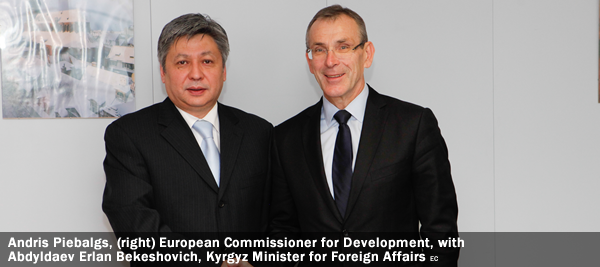Around €1 billion will be made available to support the development efforts of Central Asian countries between 2014-2020, has today announced EU Commissioner for Development, Andris Piebalgs. This amount includes the bilateral allocations for Kyrgyzstan, Tajikistan, Turkmenistan and Uzbekistan and regional allocations and multi-country funds, to support the region’s efforts on sustainable management of natural resources, socio-economic development, including education, and regional security.
Kazakhstan remains eligible to benefit from regional and thematic programmes, but not for bilateral funds.
The announcement has been made at the occasion of a Ministerial meeting between the EU and Central Asian countries, which takes place in Brussels, Wednesday. The Commissioner has also presented the priority areas of development cooperation with Central Asia, both at regional and bilateral level.
Commissioner Piebalgs said: “Governance and inclusive and sustainable growth for human development will be the two key pillars for the next seven years of development cooperation with Central Asia, with a particular focus on the poorest and the most fragile countries.”
On the overall challenges facing the region, the Commissioner underlined that “the EU can facilitate and support national efforts, but it is only the Central Asia countries’ direct determination that can build a solid basis for the prosperity and security of the region. This is precisely the idea behind the EU regional approach in Central Asia, offering each country opportunities for regional dialogue and common actions in areas crucial for the region’s future.”
After the EU-Central Asia Ministerial Plenary Session, Commissioner Piebalgs will have bilateral meetings with each of the country’s representatives to discuss and agree on the main areas of future development cooperation, which will be tailored according to each country’s modernisation and sectorial reform policies.
The finance facility for four Central Asia countries (Kyrgyzstan, Tajikistan, Turkmenistan and Uzbekistan) is authorised using bilateral allocations under the next Development Co-operation Instrument, which is part of the overall EU Budget. All these countries, as well as Kazakhstan, will remain eligible to benefit from regional and thematic programmes.
The Agenda for Change (the Commission’s blueprint to refocus its aid to prioritise those countries and sectors which need it most) calls for a concentration of resources in the regions and countries more in need.
Bilateral funding will increase as a result of orientations given by the Agenda for Change. Also in line with the principles of the Agenda for Change, Kazakhstan is one of the countries which has “graduated” (will no longer receive bilateral allocations under the new financial framework but will remain eligible for funding under the thematic and regional programmes).
For the Central Asia regional programmes, the main areas of cooperation will be: regional sustainable development, regional security for development and targeted policy advice based on EU know-how and expertise to support economic, social and institutional reforms according to country priorities and overall approximation with EU models and standards.
Over the next seven years, the EU will channel more support to the region through the Investment Facility for Central Asia, which is a new mechanism for blending loans and grants. Blending can be a key instrument to scale up available resources, catalyse investments and support the private sector. Large scale infrastructure projects (e.g. in the energy and water/environment sectors) can be effective if pursued at a regional level.
Key results of EU development cooperation commitments to Central Asia include a social services project in Tajikstan, which helped to set up electronic pension payments for more than 130,000 pensioners; decreasing the waiting time for pension delivery from 40 to 10 days (and reducing corruption risks in the process).
In the Krygz Republic, meanwhile, a programme to set up a child protection unit in each district to identify children at risk and to provide support to poor families helped 9,069 vulnerable children. 89% of the children deprived of parental care received family-based care, and only 11% of them were placed in institutions.
